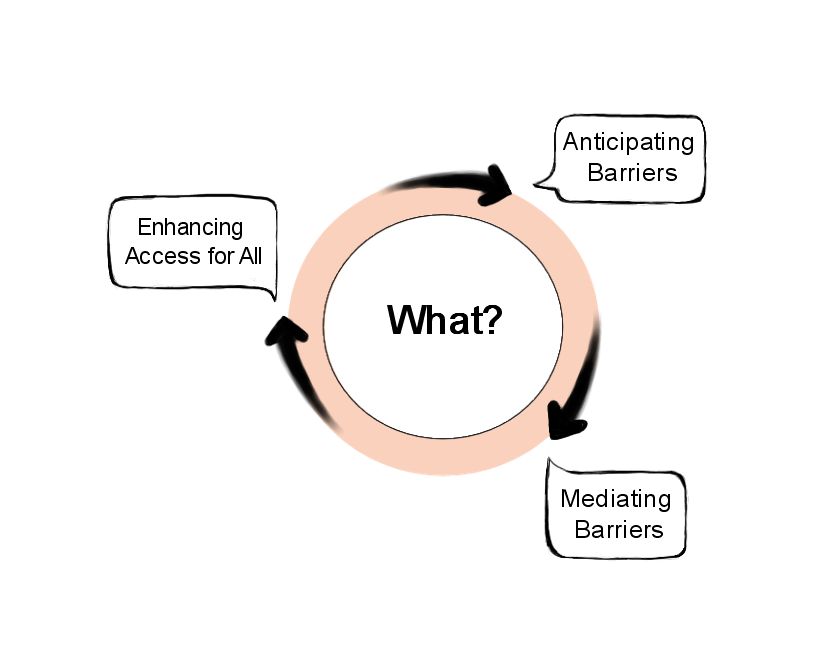Take the Next Step: Practicing Accessible Education
In this section, we review steps you can take right away to put Accessible Education into action:
- Apply an Accessible Education Perspective;
- Develop Accessible Education Teaching and Learning Goals; and
- Participate in Additional Learning Opportunities.
Apply an Accessible Education Perspective
This resource has illustrated how you might apply an accessibility perspective to different components of course design and facilitation. No doubt you have or will encounter teaching and learning situations that have not been thoroughly addressed here. This is why the focus of this resource has been to offer Accessible Education principles that can be adapted to the specificities of your context.
Accessible Education is not a destination. It is an ongoing process that continuously cycles through 3 steps: (1) Anticipating barriers and (2) finding ways to mediate these barriers (3) to enhance access for all.
We encourage you to refer back to the W5H prompts as you take action to facilitate accessibility in your teaching and learning context. The goal of these memory devices is not to enforce rigid categorizing, but to help you keep in mind how Accessible Education methods of Flexibility, Alignment, Variety, and Explicitness (FAVE) can be applied:
- To mediate any and all known, anticipated, or arising barriers;
- To any and all components of a course; and
- At all points in time throughout the life of a course from conception and design to evaluation.
Develop Accessible Education Teaching and Learning Goals
Now that you’ve spent some time reflecting on accessible teaching and how to incorporate these principles into your practice, you may want to consider:
- Developing a list of your Accessible Education teaching goals for the next 4-6 months.
- Setting aside some time to review a course document, activity, or lesson plan with Accessible Education principles in mind. For ease, we’ve gathered all of the reflection questions populated throughout the resource into this Appendix. It may be helpful to return to these in light of a specific aspect of your own teaching.
Participate in Additional Learning Opportunities
To continue developing your Accessible Education teaching practices and exchanging ideas and experiences with colleagues, we’d encourage you to explore additional learning opportunities. These may include:
- Locating and reviewing a relevant article or resource that applies accessibility principles to your discipline and/or a specific teaching tension you’re grappling with;
- Identifying a colleague with whom you can discuss accessibility in teaching and learning;
- Adding Accessible Education to the agenda of an upcoming faculty meeting in your department, or to an internal graduate studies committee meeting;
- Registering for a series of workshops on Accessibility in Teaching and Learning and other innovative teaching approaches, or education courses for graduate students and postdoctoral fellows;
- Participating in a training on the Accessibility for Ontarians with Disabilities Act (AODA), the duty to accommodate, and campus accessibility;
- Inviting an educational developer, colleague, or supervisor to observe your teaching or review course documents to offer feedback on accessibility;
- Consulting with staff from the Equity and Inclusion Office on issues related to equity in teaching and learning; or
- Contributing to additional campus-wide efforts to promote equity, inclusion, and accessibility by subscribing to the Accessibility at McMaster mailing list, joining a new accessibility network for employees, staff, and faculty with disabilities, or participating in broader equity and inclusion initiatives on campus.

